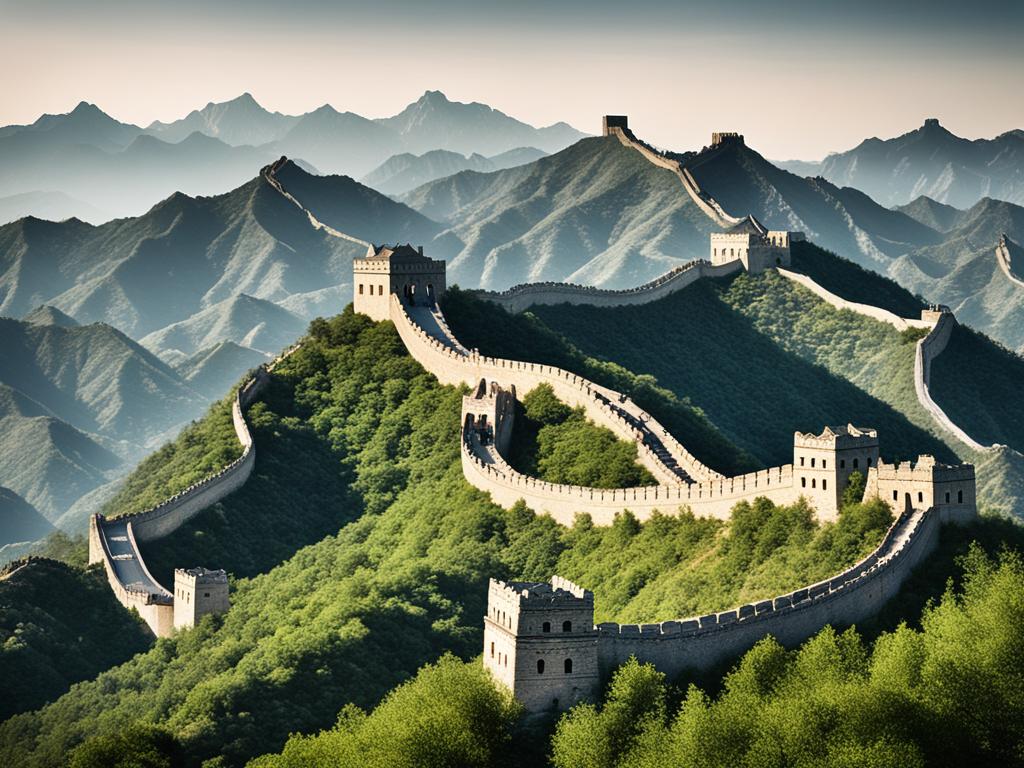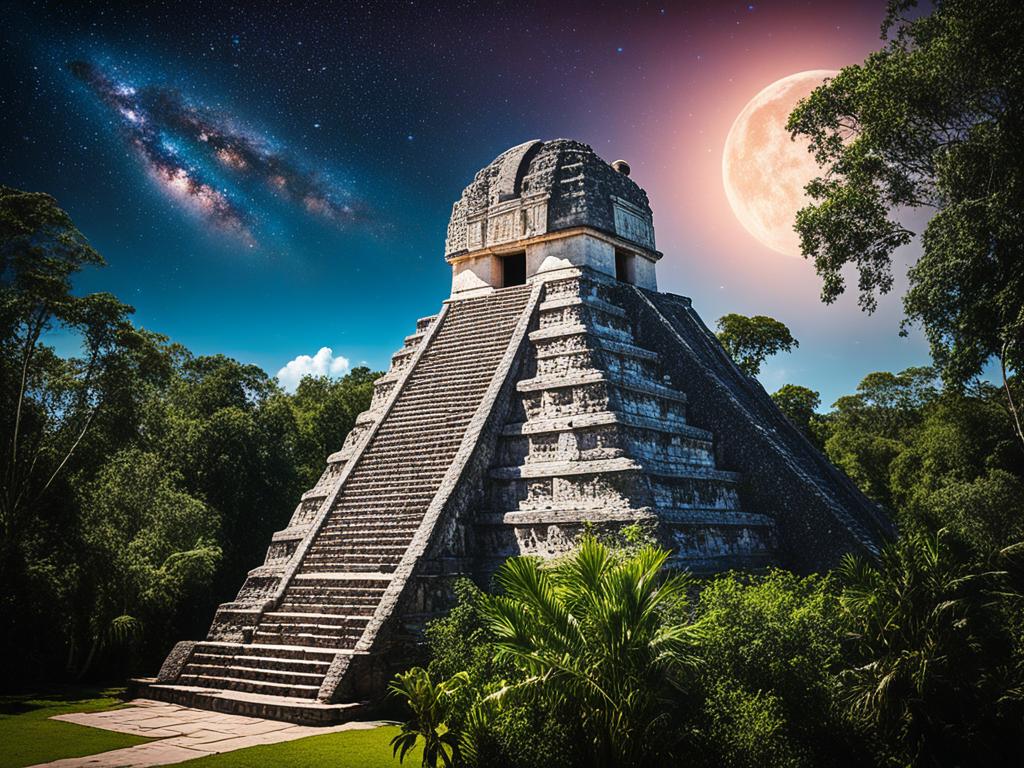Around 12,000 years ago, a big change happened for humans. They stopped moving from place to place to search for food. Instead, they started to live in one area and farm the land. This change led to the birth of the world’s first complex civilizations. These early groups lived in places like Mesopotamia, Egypt, India, China, Mesoamerica, and ancient Greece and Rome.
These ancient civilizations are the reason we have so many things today. Things like amazing buildings such as pyramids and the Great Wall of China. They also came up with the first writing, made big steps in science and math, and even started democracy.
All these achievements are why the world looks the way it does now. They have touched areas from art and buildings to how we govern and what we believe. The wonders of ancient cultures still capture our imaginations even today.
Key Takeaways
- The world’s first complex civilizations emerged around 12,000 years ago, transitioning from hunter-gatherer societies to agrarian communities.
- These ancient civilizations, including Mesopotamia, Egypt, India, China, Mesoamerica, and ancient Greece and Rome, left a lasting impact on art, architecture, religion, philosophy, and cultural values.
- Remarkable achievements of these civilizations include the construction of monumental structures, development of writing systems, advancements in science and mathematics, and the birth of democracy.
- The enduring legacy of these ancient civilizations continues to shape the modern world in various fields, from art and architecture to governance and societal values.
- The influence of these ancient cultures can be seen in the enduring symbols, artistic traditions, and philosophical concepts that continue to inspire and captivate people worldwide.
The Emergence of Civilizations
Around 12,000 years ago, humans shifted from hunting and gathering to farming. This change marked a key moment in our history. The shift allowed people to grow crops, creating a surplus food.
This surplus food made it possible for people to live in one place year-round. These places became the first agrarian settlements. Over time, these settlements became cities. In these growing urban areas, people could focus on more than just producing food. This led to the growth of art, buildings, writing, and scientific achievements. These cultural advancements laid the foundation for our first complex civilizations.
Agrarian Settlements and the Rise of Cities
The move from a wandering hunter-gatherer life to farming sparked major changes. People started living in one place, thanks to the steady surplus food. Soon, these places evolved into agrarian settlements. And later, into the first cities.
As these cities’ populations grew, people began specializing. They no longer all had to farm for food. This shift allowed for the development of new skills and jobs. Soon, cities were filled with artisans, writers, and leaders. This was the start of our first complex civilizations.
Surplus Food Production and Specialization
Cultivating crops and having a surplus food was a breakthrough for early humans. This extra food let some people do more than just survive. They started taking on unique roles. These included jobs like making art, keeping records, and managing communities.
With enough food to go around, society could support a diverse range of activities. This led to major cultural achievements. It set the stage for the birth of the first big civilizations in the world.
Groundbreaking Ancient Civilizations
The earliest and most influential Groundbreaking Ancient Civilizations appeared in Mesopotamia, Egypt, India, China, Mesoamerica, and ancient Greece and Rome. These Cradles of Civilization created new tools, farming methods, writing ways, and amazing buildings. They have shaped the way we live even now. From Sumerians’ cuneiform to the Egyptian pyramids, and from the Indus Valley cities to China’s Great Wall, these societies started much of our culture, tech, and politics.
These Historical Empires made their mark in the past, but their finds keep us amazed today. Their big buildings, writing ways, and science progress changed human history greatly.
| Ancient Civilization | Timeline | Noteworthy Achievements |
|---|---|---|
| Sumerian Civilization | 4500 B.C. to 1900 B.C. | Invention of cuneiform writing, advancements in mathematics, astronomy, and law |
| Indus Valley Civilization | 3300 B.C. to 1300 B.C. | Sophisticated urban planning, baked-brick buildings, advanced sanitation systems, and standardized weights and measures |
| Ancient Egypt | 3100 B.C. to 30 B.C. | Monumental architecture, including pyramids and grand temples, hieroglyphic writing, and advancements in fields such as arithmetic, astronomy, and medicine |
| Ancient and Early Imperial China | 2070 B.C. to A.D. 220 | Centralized governance under dynastic rule, innovations like silk, paper, and printing technologies, and the construction of the Great Wall |
| Ancient Maya Civilization | 1000 B.C. to A.D. 1520 | Sophisticated astronomical observations, complex timekeeping systems, intricate writing, and advancements in mathematics and astronomy |
| Ancient Greece | 1100 B.C. to A.D. 140 | Pioneering literature, philosophy, and the development of democracy, laying the foundations of Western thought |
| Ancient Rome | N/A | Architectural innovations, such as the arch and dome, and the creation of monumental buildings, realistic portraiture, and intricate mosaics |
These Groundbreaking Ancient Civilizations changed art, architecture, religion, philosophy, and culture forever. Their big changes still inspire the world, from scholars to artists, and thinkers.

Sumerian Civilization: The Cradle of Civilization
The Sumerians lived in the Mesopotamian area of the Fertile Crescent. They are the earliest known civilization. Starting around 4500 B.C., cities like Eridu, Uruk, and Ur were among the first urban places ever. They had impressive temple and palace areas.
The Fertile Crescent and the First Cities
Living in the Fertile Crescent, the Sumerians enjoyed its farming resources. Their cities were big for their time. Uruk, for example, had between 40,000 and 80,000 people around 2800 B.C. Their use of the area’s benefits helped create the first complex societies.
Cuneiform Writing and the Spread of Knowledge
The Sumerians are known for creating the written word. Their language was first found in records around 3100 B.C. They used a system called cuneiform to write. This system could record trading, tell stories, and share scientific findings. Sumerians are credited with creating the oldest known laws, around 2400 B.C.
Pioneering Mathematics, Astronomy, and Law
Besides writing, the Sumerians excelled in math, astronomy, and creating laws. They set a base-60 system for numbers. This influenced how time is measured today. They were also keen on the stars, using astrology for guidance. The Sumerians wrote down legal codes as well, showing their deep understanding of law and society.
| Sumerian Achievements | Date |
|---|---|
| First settlement of Sumer | 4500-4000 B.C. |
| Peak population of Uruk | 2800 B.C. |
| Appearance of Sumerian language | 3100 B.C. |
| Oldest written laws | 2400 B.C. |
| Appearance of ziggurats | 2200 B.C. |
| Akkadian sculpture reaches new heights | 2100 B.C. |
| Sumerian numbering system and timekeeping | Developed |
| First epic poem: The Epic of Gilgamesh | Composed |
Indus Valley Civilization: Urban Planning and Standardization
Around 7000 B.C., people started small farms in the Indus River Valley. This area is now part of India and Pakistan. By 3300 B.C., these settlements grew into big cities. Harappa and Mohenjo-daro might have had up to 50,000 people each. The Indus Valley Civilization is famous for its well-planned cities. It had brick buildings, clean water, and a clear layout, showing great organization.
Cities of Harappa and Mohenjo-daro
The Indus Valley Civilization boasted two significant urban centers. Harappa and Mohenjo-daro were its largest cities. They also had over 100 smaller communities. Harappa might have had 23,500-35,000 residents. In comparison, Mohenjo-daro could house 35,000-41,250 people. These numbers show us just how big and developed these ancient cities were.
Advanced Sanitation and Grid Structure
In these cities, urban planning and standardization were taken very seriously. They had flush toilets, a drainage system, and set sizes for buildings. Such detail in grid structure suggests they had well-thought-out administrative and technological skills. This was cutting edge in the ancient times.
Weights, Measures, and an Undeciphered Script
Aside from their city planning, the Indus Valley Civilization was ahead in other areas too. They created a system for weights and measures. They also had a written language that we still don’t understand. These facts highlight how clever and organized this ancient society was.
Ancient Egypt: Monumental Architecture and Cultural Symbols
By 6000 B.C., ancestors settled in the Nile River Valley, turning a desert into an oasis. Around 3100 B.C., these places grew into big cities, led by pharaohs who were more than kings. They were seen as messengers of the gods. This age-old realm left its mark through grand monumental architecture. These include the famous pyramids and the majestic temples built for their gods.
The Nile River Valley and Pharaonic Rule
Life boomed in the Nile River Valley until Cleopatra VII’s time, around 30 B.C. The last Pharaonic ruler, Cleopatra, passed away then. They were passionate about preserving life’s essence, as seen in their many tombs and mummies. The Egyptians believed their deities kept the world in balance, which they loved to honor and thank for.
Pyramids, Temples, and the Sphinx
Egyptians are famous for their architectural feats like the renowned pyramids and breathtaking temples. There’s also the iconic Sphinx. This lion-bodied, human-headed statue still stands as a symbol. Baked with mud bricks and marked with hieroglyphics, the Great Pyramid of Khufu stands 481.4 feet tall, a true masterpiece.
Hieroglyphics, Papyrus, and Advancements in Knowledge
Ancient Egypt made incredible leaps in math, space, biology, and health. They crafted a writing system, called hieroglyphic writing, using carvings and papyrus. These achievements and their unique symbols have forever shaped not just Egypt, but the world’s history.
| Architectural Achievements | Technological Advancements |
|---|---|
| Pyramids, Temples, and the Sphinx | Hieroglyphics, Papyrus, and Astronomy |
| The Great Pyramid of Khufu, measuring 755.43 to 756.08 feet on each side and standing 481.4 feet tall | Invention of a complex system of hieroglyphic writing, advancements in arithmetic, astronomy, anatomy, and medicine |
| Construction using a combination of unbaked mud brick and stone | Development of the water clock and calendar by 1600 BCE |
Ancient and Early Imperial China: Centralized Governance and Inventions
The Yellow River Valley in Ancient China was home to one of the oldest civilizations. The first farming settlements started around 5000 B.C. These evolved into a government controlled by different dynasties like the Xia, Shang, and Zhou. They led civilization forward. The idea of the “Mandate of Heaven” lead rulers to care for their people. This ensured good times and bad still saw the growth of Chinese culture.
Silk, Paper, and Printing Technologies
Chinese artisans and inventors played a huge role. They made silk, paper, and the first block printing. These changes helped spread information and knowledge in new ways.
The Great Wall and Architectural Achievements
The Great Wall of China started in the 7th century B.C. Its building is a sign of Ancient China’s and Early Imperial China’s skill in engineering and architecture.

Great Civilizations and Their Cultural Legacy
Ancient civilizations like those in Mesopotamia, Egypt, and Greece have greatly influenced our world. Their artistic traditions, architectural marvels, and religious beliefs are still seen today. They have left a significant, lasting mark on the way we live and think.
Artistic Traditions and Architectural Marvels
The great pyramids in Egypt and the detailed art in Rome are famous examples. These stunning pieces of art and architecture show the heights of ancient culture and skill. They still inspire awe and wonder, showcasing their civilization’s achievements.
Religious Beliefs and Philosophical Concepts
Ancient religious beliefs include reincarnation in Hinduism and the divine rule in China. Philosophical ideas from Greece also shaped how we understand the world. These beliefs and thoughts influence us today, showing the power of ancient wisdom.
Societal Values and Enduring Influence
Their societal values and how they governed, like in ancient Greece, are still relevant. Their legacy lives on through our laws and democratic systems. The impact of these great civilizations on human history is profound and ongoing.
Ancient Maya Civilization: Astronomical Observations and Timekeeping
The ancient Maya people lived in what is now southeastern Mexico, Guatemala, and Belize. They are famous for their work in astronomy and keeping time. The Maya started as farmers around 7000 B.C., then built larger societies by 1000 B.C. Their cities featured grand buildings used for both religious and political purposes.
Cities and Ceremonial Complexes
The Maya built large cities planned around temple pyramids, palaces, and plazas. These areas were not just for ceremonies. They were centers of religion, politics, and the study of the sky. They showed a great interest in the stars and planets above.
Intricate Writing System and Calendar
The Maya created a unique writing system that used pictures and sounds. With this system, they wrote about their ideas, history, and ceremonies. They also had a sophisticated way to keep track of time. By using different calendars, they could organize farming and religious events.
Mathematical and Astronomical Advancements
The Maya were highly skilled in both math and astronomy. They carefully observed the sky, noting the movements of the sun, moon, and planets. They used this knowledge to align their buildings with certain points in the sky. This allowed them to watch special celestial events from particular places. Today, we still marvel at how they combined astronomy and architecture.

Ancient Greece: The Foundations of Western Thought
Ancient Greece marked the world with its impact on thought and culture. Even though they weren’t the first in the Mediterranean, they founded many Western ideas. The Greek world started with small settlements that grew into powerful, independent city-states like Athens and Sparta. Each city-state had its unique traditions and beliefs.
From Minoans and Mycenaeans to City-States
Greece saw a new era after the Mycenaean time, marked by the Dorian invasion. This new period brought the Archaic and Classical times. Some believed in a “Dark Age” for Greece, but recent findings tell a different story. For example, discoveries like rich graves in places like Euboea show an advanced society much earlier than previously thought. This finding changed what we knew about early Greek building practices.
Literature, Philosophy, and the Birth of Democracy
Homer and Hesiod set the stage for Western literature with their writings. Meanwhile, people like Socrates, Plato, and Aristotle shaped modern thought. Socrates’ teaching method, still used today, challenged his students to think deeply. Plato left a huge philosophical legacy with his many books on different topics.
But it was Athens that introduced democracy to the world, a key concept in politics. Today, most nations follow some democratic principles. The influence of ancient Greece on the Western world remains strong to this day.
Ancient Rome: Engineering Marvels and Artistic Influence
The Romans built on what the Greeks started with their architecture. They got creative, inventing new methods that are still used by builders today. The Colosseum and the Pantheon are good examples. They are huge and show how smart the Romans were.
Roman art was mostly influenced by the Greeks but with their twist. The Romans were great at making life-like portraits and detailed mosaics. Their work left a big mark on our art today, showing up in various forms of modern art.
The wonders of Roman engineering and art still impress us today. They are reminders of what a powerful and smart civilization Ancient Rome was. They continue to be a big inspiration for people worldwide.
The Enduring Legacies of Ancient Civilizations
Thousands of years ago, ancient civilizations appeared around the world. Their cultural influence, architectural achievements, and artistic traditions shaped the world. Ancient Egypt and China built grand structures. Greece’s philosophical traditions and Rome’s engineering marvels led to advancements we enjoy today.
The artistic traditions of these civilizations left a significant mark. From the detailed mosaics of Rome to India’s vibrant sculptures, their work influences us still. The religious beliefs and philosophical concepts from China’s “Mandate of Heaven” to Greece’s philosophers shape how we understand life and ethics.
Ancient civilizations show our ingenuity and resilience. Their scientific and mathematical discoveries fuel our knowledge and progress. Their cultural, architectural, and intellectual achievements deeply influence our world. Their contributions remain vital, leaving a lasting legacy on history.
Source Links
- https://www.discovermagazine.com/planet-earth/7-groundbreaking-ancient-civilizations-that-influence-us-today
- https://medium.com/@kmoni4931/ancient-civilizations-their-art-architecture-and-legacy-69e0b2ada98f
- https://www.history.com/news/first-earliest-human-civilizations
- https://education.nationalgeographic.org/resource/key-components-civilization
- https://ramchandra-vadranam.medium.com/lost-in-time-the-enigmatic-legacy-of-ancient-civilizations-2874661ffc10
- https://www.history.com/topics/ancient-middle-east/sumer
- https://global.si.edu/success-stories/cradle-civilization-new-generation-preserves-heritage
- https://en.wikipedia.org/wiki/Cradle_of_civilization
- https://www.britannica.com/topic/Indus-civilization
- https://www.worldhistory.org/Indus_Valley_Civilization/
- https://en.wikipedia.org/wiki/Indus_Valley_Civilisation
- https://www.worldhistory.org/Egyptian_Culture/
- https://www.britannica.com/art/Egyptian-architecture
- https://www.history.com/topics/ancient-egypt/ancient-egypt
- https://china.usc.edu/sites/default/files/forums/Chinese Inventions.pdf
- https://www.history.com/topics/ancient-china/qin-dynasty
- https://en.wikipedia.org/wiki/History_of_China
- https://mayorgacoffee.com/blogs/news/embracing-cultural-legacy-honoring-indigenous-civilizations
- https://www.history.com/topics/ancient-americas/mayan-scientific-achievements
- https://www.thoughtco.com/ancient-maya-astronomy-2136314
- https://education.nationalgeographic.org/resource/lasting-legacy-ancient-greek-leaders-and-philosophers/
- https://crunchlearning.com/legacy-of-ancient-greece/
- https://www.britannica.com/place/ancient-Greece
- https://www.history.com/news/10-innovations-that-built-ancient-rome
- https://onlineme.engr.utexas.edu/ancient-rome-an-engineering-marvel/
- https://rhakotis.com/2020/08/19/legacy/
- https://medium.com/@omisakinmonioluwa/the-enduring-legacy-of-ancient-civilizations-54e8b31a2abb


